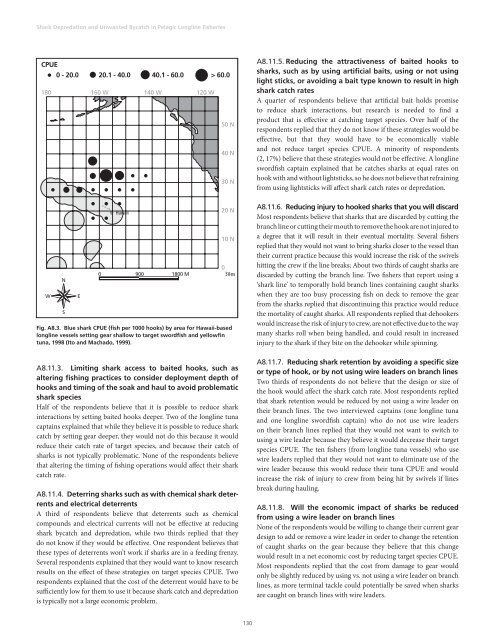Shark Depredation and Unwanted Bycatch in Pelagic Longline
Shark Depredation and Unwanted Bycatch in Pelagic Longline
Shark Depredation and Unwanted Bycatch in Pelagic Longline
You also want an ePaper? Increase the reach of your titles
YUMPU automatically turns print PDFs into web optimized ePapers that Google loves.
<strong>Shark</strong> <strong>Depredation</strong> <strong>and</strong> <strong>Unwanted</strong> <strong>Bycatch</strong> <strong>in</strong> <strong>Pelagic</strong> Longl<strong>in</strong>e Fisheries<br />
A8.11.5. Reduc<strong>in</strong>g the attractiveness of baited hooks to<br />
sharks, such as by us<strong>in</strong>g artificial baits, us<strong>in</strong>g or not us<strong>in</strong>g<br />
light sticks, or avoid<strong>in</strong>g a bait type known to result <strong>in</strong> high<br />
shark catch rates<br />
A quarter of respondents believe that artificial bait holds promise<br />
to reduce shark <strong>in</strong>teractions, but research is needed to f<strong>in</strong>d a<br />
product that is effective at catch<strong>in</strong>g target species. Over half of the<br />
respondents replied that they do not know if these strategies would be<br />
effective, but that they would have to be economically viable<br />
<strong>and</strong> not reduce target species CPUE. A m<strong>in</strong>ority of respondents<br />
(2, 17%) believe that these strategies would not be effective. A longl<strong>in</strong>e<br />
swordfish capta<strong>in</strong> expla<strong>in</strong>ed that he catches sharks at equal rates on<br />
hook with <strong>and</strong> without lightsticks, so he does not believe that refra<strong>in</strong><strong>in</strong>g<br />
from us<strong>in</strong>g lightsticks will affect shark catch rates or depredation.<br />
Fig. A8.3. Blue shark CPUE (fish per 1000 hooks) by area for Hawaii-based<br />
longl<strong>in</strong>e vessels sett<strong>in</strong>g gear shallow to target swordfish <strong>and</strong> yellowf<strong>in</strong><br />
tuna, 1998 (Ito <strong>and</strong> Machado, 1999).<br />
A8.11.6. Reduc<strong>in</strong>g <strong>in</strong>jury to hooked sharks that you will discard<br />
Most respondents believe that sharks that are discarded by cutt<strong>in</strong>g the<br />
branch l<strong>in</strong>e or cutt<strong>in</strong>g their mouth to remove the hook are not <strong>in</strong>jured to<br />
a degree that it will result <strong>in</strong> their eventual mortality. Several fishers<br />
replied that they would not want to br<strong>in</strong>g sharks closer to the vessel than<br />
their current practice because this would <strong>in</strong>crease the risk of the swivels<br />
hitt<strong>in</strong>g the crew if the l<strong>in</strong>e breaks; About two thirds of caught sharks are<br />
discarded by cutt<strong>in</strong>g the branch l<strong>in</strong>e. Two fishers that report us<strong>in</strong>g a<br />
‘shark l<strong>in</strong>e’ to temporally hold branch l<strong>in</strong>es conta<strong>in</strong><strong>in</strong>g caught sharks<br />
when they are too busy process<strong>in</strong>g fish on deck to remove the gear<br />
from the sharks replied that discont<strong>in</strong>u<strong>in</strong>g this practice would reduce<br />
the mortality of caught sharks. All respondents replied that dehookers<br />
would <strong>in</strong>crease the risk of <strong>in</strong>jury to crew, are not effective due to the way<br />
many sharks roll when be<strong>in</strong>g h<strong>and</strong>led, <strong>and</strong> could result <strong>in</strong> <strong>in</strong>creased<br />
<strong>in</strong>jury to the shark if they bite on the dehooker while sp<strong>in</strong>n<strong>in</strong>g.<br />
A8.11.3. Limit<strong>in</strong>g shark access to baited hooks, such as<br />
alter<strong>in</strong>g fish<strong>in</strong>g practices to consider deployment depth of<br />
hooks <strong>and</strong> tim<strong>in</strong>g of the soak <strong>and</strong> haul to avoid problematic<br />
shark species<br />
Half of the respondents believe that it is possible to reduce shark<br />
<strong>in</strong>teractions by sett<strong>in</strong>g baited hooks deeper. Two of the longl<strong>in</strong>e tuna<br />
capta<strong>in</strong>s expla<strong>in</strong>ed that while they believe it is possible to reduce shark<br />
catch by sett<strong>in</strong>g gear deeper, they would not do this because it would<br />
reduce their catch rate of target species, <strong>and</strong> because their catch of<br />
sharks is not typically problematic. None of the respondents believe<br />
that alter<strong>in</strong>g the tim<strong>in</strong>g of fish<strong>in</strong>g operations would affect their shark<br />
catch rate.<br />
A8.11.4. Deterr<strong>in</strong>g sharks such as with chemical shark deterrents<br />
<strong>and</strong> electrical deterrents<br />
A third of respondents believe that deterrents such as chemical<br />
compounds <strong>and</strong> electrical currents will not be effective at reduc<strong>in</strong>g<br />
shark bycatch <strong>and</strong> depredation, while two thirds replied that they<br />
do not know if they would be effective. One respondent believes that<br />
these types of deterrents won’t work if sharks are <strong>in</strong> a feed<strong>in</strong>g frenzy.<br />
Several respondents expla<strong>in</strong>ed that they would want to know research<br />
results on the effect of these strategies on target species CPUE. Two<br />
respondents expla<strong>in</strong>ed that the cost of the deterrent would have to be<br />
sufficiently low for them to use it because shark catch <strong>and</strong> depredation<br />
is typically not a large economic problem.<br />
A8.11.7. Reduc<strong>in</strong>g shark retention by avoid<strong>in</strong>g a specific size<br />
or type of hook, or by not us<strong>in</strong>g wire leaders on branch l<strong>in</strong>es<br />
Two thirds of respondents do not believe that the design or size of<br />
the hook would affect the shark catch rate. Most respondents replied<br />
that shark retention would be reduced by not us<strong>in</strong>g a wire leader on<br />
their branch l<strong>in</strong>es. The two <strong>in</strong>terviewed capta<strong>in</strong>s (one longl<strong>in</strong>e tuna<br />
<strong>and</strong> one longl<strong>in</strong>e swordfish capta<strong>in</strong>) who do not use wire leaders<br />
on their branch l<strong>in</strong>es replied that they would not want to switch to<br />
us<strong>in</strong>g a wire leader because they believe it would decrease their target<br />
species CPUE. The ten fishers (from longl<strong>in</strong>e tuna vessels) who use<br />
wire leaders replied that they would not want to elim<strong>in</strong>ate use of the<br />
wire leader because this would reduce their tuna CPUE <strong>and</strong> would<br />
<strong>in</strong>crease the risk of <strong>in</strong>jury to crew from be<strong>in</strong>g hit by swivels if l<strong>in</strong>es<br />
break dur<strong>in</strong>g haul<strong>in</strong>g.<br />
A8.11.8. Will the economic impact of sharks be reduced<br />
from us<strong>in</strong>g a wire leader on branch l<strong>in</strong>es<br />
None of the respondents would be will<strong>in</strong>g to change their current gear<br />
design to add or remove a wire leader <strong>in</strong> order to change the retention<br />
of caught sharks on the gear because they believe that this change<br />
would result <strong>in</strong> a net economic cost by reduc<strong>in</strong>g target species CPUE.<br />
Most respondents replied that the cost from damage to gear would<br />
only be slightly reduced by us<strong>in</strong>g vs. not us<strong>in</strong>g a wire leader on branch<br />
l<strong>in</strong>es, as more term<strong>in</strong>al tackle could potentially be saved when sharks<br />
are caught on branch l<strong>in</strong>es with wire leaders.<br />
130












